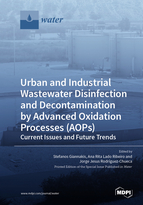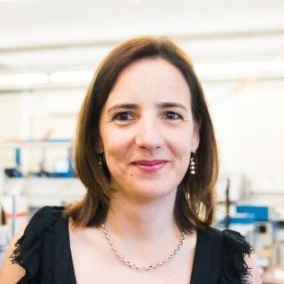Urban and Industrial Wastewater Disinfection and Decontamination by Advanced Oxidation Processes (AOPs): Current Issues and Future Trends
A special issue of Water (ISSN 2073-4441). This special issue belongs to the section "Wastewater Treatment and Reuse".
Deadline for manuscript submissions: closed (31 October 2020) | Viewed by 44343
Special Issue Editors
Interests: advanced oxidation processes (AOPs) for microbial disinfection (UV/H2O2, fenton, SO42-, and TiO2, O3); photochemistry of natural waters; environmental chemistry and microbiology; solar-based water purification processes
Interests: occurrence and distribution of multi-class organic micropollutants in water/wastewater; analytical tools for determination of organic micropollutants; identification of by-products; advanced oxidation processes: membrane technologies
Special Issues, Collections and Topics in MDPI journals
Interests: water and wastewater treatment; water quality; water management; wastewater reuse; advanced treatments; environmental engineering
Special Issues, Collections and Topics in MDPI journals
Special Issue Information
Dear Colleagues,
Dynamic changes in our modern lifestyle and the rise of living standards have led to significant modifications to the composition and characteristics of urban effluents. Owning to the high consumption of chemical substances, such as antibiotics, licit and illicit drugs, medical products, cleaning agents, etc., our everyday life and habitats have been converted to a small-scale industrial plant. This evolution, alongside intensified industrial activities to meet consumer demand, has aggravated the problems of wastewater treatment, to a degree beyond the capacity of regular wastewater treatment plants (WWTPs).
The necessity for proper wastewater (WW) treatment calls for novel, sophisticated methods of decontamination prior to its discharge or reuse. Emerging threats such as antibiotic-resistant bacteria (ARB) and the contaminants of emerging concern (chemicals, microplastics) demand efficient, end-of-pipe solutions before their discharge in the environment or reclamation for reuse purposes. As such, advanced oxidation processes (AOPs) have been procured as effective methods for WW disinfection and decontamination.
In the face of the challenges of modern WW treatment and WWTP operation, this Special Issue is devoted to a wholistic approach towards WWTP matters, focusing to the use of AOPs as an effective solution of pre-treatment or a polishing step for urban or industrial WW effluents. The topics dealt within this Issue include the following:
Treatment targets:
- Typical urban WW microorganisms (bacteria, viruses, protozoa, etc.);
- The contaminants of emerging concern (CECs), including chemicals and microplastics;
- Antibiotic resistant bacteria and genes (ARB and ARG).
as defined by the
- EU Watch List;
- European One Health Action Plan against antimicrobial resistance (AMR);
- Swiss FOEN Legislation for Micropollutants;
- US EPA Emerging Contaminants and Federal Facility Contaminants of Concern;
- Chinese legislation (GB-18918).
Occurrence and Monitoring Issues:
- Advances and challenges in analytical chemistry applied to wastewater treatment;
- Emerging, geographically distinctive/problematic effluents (local case studies).
Wastewater Treatment Methods to be Considered:
- Advanced Oxidation Processes (AOPs)
- UV-based technologies (UV/H2O2, UV/Cl, etc.);
- Fenton and photo-Fenton processes;
- TiO2 photocatalysis;
- Sulfate radical-mediated processes (SR-AOPs);
- Ozone-based processes;
- Electrochemical AOPs;
- Ultrasound and plasma treatment;
- Coupling of AOPs with membranes;
- Coupling among AOPs (e.g., photo-electro-Fenton, UV/H2O2/O3);
- Coupling of AOPs with biological treatments (ABOPs).
- Advances in materials, catalysts, and methods in AOPs for WW treatment:
- Nano-materials and nano-catalysts;
- Next-gen TiO2-based derivatives, photo-catalytic membranes;
- Graphene and graphitic nitride materials.
Dr. Stefanos Giannakis
Dr. Ana Rita Lado Ribeiro
Prof. Dr. Jorge Rodríguez-Chueca
Guest Editors
Manuscript Submission Information
Manuscripts should be submitted online at www.mdpi.com by registering and logging in to this website. Once you are registered, click here to go to the submission form. Manuscripts can be submitted until the deadline. All submissions that pass pre-check are peer-reviewed. Accepted papers will be published continuously in the journal (as soon as accepted) and will be listed together on the special issue website. Research articles, review articles as well as short communications are invited. For planned papers, a title and short abstract (about 100 words) can be sent to the Editorial Office for announcement on this website.
Submitted manuscripts should not have been published previously, nor be under consideration for publication elsewhere (except conference proceedings papers). All manuscripts are thoroughly refereed through a single-blind peer-review process. A guide for authors and other relevant information for submission of manuscripts is available on the Instructions for Authors page. Water is an international peer-reviewed open access semimonthly journal published by MDPI.
Please visit the Instructions for Authors page before submitting a manuscript. The Article Processing Charge (APC) for publication in this open access journal is 2600 CHF (Swiss Francs). Submitted papers should be well formatted and use good English. Authors may use MDPI's English editing service prior to publication or during author revisions.
Keywords
- Advanced oxidation processes (AOPs)
- UV-driven technologies
- Solar-based AOPs
- Photocatalysis
- Wastewater disinfection
- Contaminants of emerging concern
- Antibiotic resistant bacteria (ARB)
- Antibiotic resistance genes (ARG)
- Wastewater regeneration








